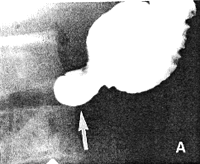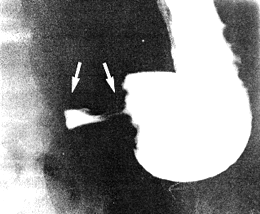


Go to chapter: 1 | 2 | 3 | 4 | 5 | 6 | 7 | 8 | 9 | 10 | 11 | 12 | 13 | 14 | 15 | 16 | 17 | 18 | 19 | 20 | 21 | 22 | 23 | 24 | 25 | 26 | 27 | 28 | 29 | 30 | 31 | 32 | 33 | 34 | 35 | 36 | 37 | 38 | 39
Chapter 12 (page 48)




Go to chapter: 1 | 2 | 3 | 4 | 5 | 6 | 7 | 8 | 9 | 10 | 11 | 12 | 13 | 14 | 15 | 16 | 17 | 18 | 19 | 20 | 21 | 22 | 23 | 24 | 25 | 26 | 27 | 28 | 29 | 30 | 31 | 32 | 33 | 34 | 35 | 36 | 37 | 38 | 39
Chapter 12 (page 48)
 |  |
 |  |
| Fig. 12.2 A-D. Patient J.S. Initial hold-up at pyloric ring (A, B). Successive, incomplete contractions of pyloric sphincteric cylinder (arrow). Emptying into duodenum (C, D) | |
Generally speaking a similar sequence of events was seen in the majority of patients in this group, namely a short hold-up at the pyloric ring, followed by 2 or 3 incomplete (or occasionally maximal) contractions of the pyloric sphincteric cylinder and commencing emptying into the duodenum (Fig. 12.3). The degree of dynamic narrowing of the lumen, as seen radiologically, probably corresponds to the amplitude as measured manometrically. This varied greatly among subjects.
 |
Fig. 12.3. The first of two or three maximal contractions of pyloric sphincteric cylinder (arrows) preceding emptying into duodenum |
In a minority of subjects in this group the period of hold-up at the pyloric
ring was longer, lasting at least 90 seconds and sometimes as long as 2 to
3 minutes. In these patients the stomach invariably had a long, hanging,
fish-hook shape, with a sagging greater curvature, which is evidence of
hypotonia (Chap. 19). Tilting the table to an angle of 45
degrees, and turning the patient into the left anterior oblique position
(i.e. with the right side down), invariably caused immediate
emptying into the duodenum even in the absence of visible motor activity.
The following case is an example:
Previous Page | Table of Contents | Next Page
© Copyright PLiG 1998